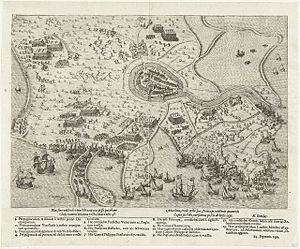Siege of Hulst (1591) facts for kids
Quick facts for kids Siege of Hulst (1591) |
|||||||
|---|---|---|---|---|---|---|---|
| Part of the Eighty Years' War & the Anglo–Spanish War | |||||||
 The siege and capture of Hulst: print by Pieter Bast |
|||||||
|
|||||||
| Belligerents | |||||||
| Commanders and leaders | |||||||
| Strength | |||||||
| 4,000 infantry 600 cavalry |
400 | ||||||
| Casualties and losses | |||||||
| Light | All captured | ||||||
The Siege of Hulst was a short but important battle that happened in the city of Hulst. This city is in what we now call the Netherlands. The battle took place from September 20 to 24, 1591.
A combined army of Dutch and English soldiers attacked Hulst. They were led by a famous commander named Maurice of Orange. This siege was part of two bigger conflicts: the Eighty Years' War and the Anglo–Spanish War. It was also a key part of Maurice's very successful military plan in 1591.
Contents
Why Hulst Was Attacked
Maurice's Earlier Victories
Before attacking Hulst, Maurice of Orange had already won some big battles in 1591. His army had captured cities like Zutphen, Deventer, and Delfzijl. In these places, the Spanish soldiers who were guarding the cities had to give up.
Maurice's army was strong and included soldiers from different places. There were sixteen groups of English soldiers led by Sir Francis Vere. There were also ten groups of Scots soldiers.
A Clever Plan
After these wins, Maurice's army faced the Spanish forces of the Duke of Parma. They fought at a fort called Knodsenburg, near Nijmegen. Maurice's army won that battle too.
Then, Maurice made it look like his army was going to stop fighting for the winter. This was a trick! Instead, he secretly moved his army to Hulst. This clever plan worked perfectly.
The Spanish soldiers guarding Hulst thought they were safe. Nearly half of them had been sent to other places. This left only about 400 Spanish troops in the city. They were not ready for an attack.
The Siege and Its Outcome
The Surprise Attack
Maurice arrived at Hulst on September 19, just as he had planned. He quickly took advantage of the situation. The city was not well-defended, so he started the siege right away.
Maurice wanted to win quickly. He ordered his army to fire their cannons non-stop. The Spanish commander, Colonel Castillo, was completely surprised. He and his small group of soldiers could not fight back much.
Hulst Falls
After five days of constant bombing, Colonel Castillo knew he couldn't win. No help was coming from outside the city. So, he asked Maurice for terms to surrender. Maurice agreed.
The Spanish soldiers were allowed to march out of Hulst with their weapons. This was called "honours of war." It meant they surrendered with dignity.
Spanish Reaction
News of Hulst's surrender shocked the Spanish leaders. They were in Antwerp at the time, celebrating the Duke of Parma's son. The Duke of Parma was very angry about what happened. He ordered that Colonel Castillo be immediately punished for losing Hulst.
What Happened Next
After capturing Hulst, Maurice set up defenses around the area. This helped him keep control of the city. He then made secret plans to attack Nijmegen next. The Spanish thought he would attack a different city, Geertruidenberg.
Maurice's clever plan worked again. After a week-long siege, Maurice captured Nijmegen. This victory ended his very successful military campaign in 1591.
Hulst stayed in Dutch hands for five years. But in 1596, Spanish forces led by Archduke of Austria took the city back. Hulst remained under Spanish control until 1645. That year, it was captured by the Dutch again in one of the last sieges of the war.

